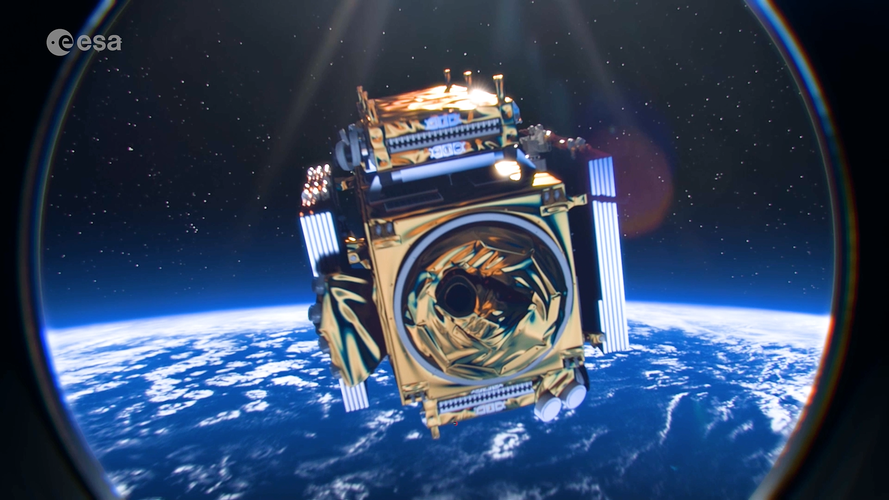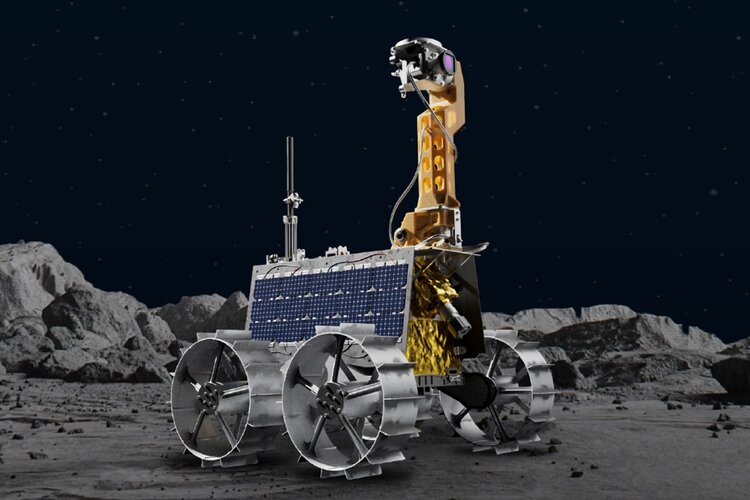ESA Preview 2023
Thursday, 12 January 2023 10:00 Video:
00:06:33
Video:
00:06:33
At the start of 2023 the European Space Agency ESA is happily looking forward to another year filled with a host of thrilling new missions, cutting edge science and the continued effort to guarantee independent access to space for Europe. We will see the first images of the first Meteosat Third Generation satellite, the launch of the Jupiter Icy Moons Explorer, and of Euclid and another Sentinel-1 satellite launch. It will also be the year of Ariane 6 which will make its inaugural flight and the first Dane in space, Andreas Mogensen will return to the ISS
ESA to touch Moon from wheels of UAE Rashid rover
Thursday, 12 January 2023 07:10
The very first European technology to make contact with the surface of the Moon will be on the wheels of the Rashid rover, part of the Emirates Lunar Mission currently on the way to our natural satellite. The outer rims of this rover’s four wheels incorporate small sample panels to test how differing materials cope with the abrasive lunar surface, including a quartet of samples contributed by ESA.
Russia to send rescue mission to space station
Thursday, 12 January 2023 05:55 Russia said Wednesday that it will send an empty spacecraft to the International Space Station (ISS) next month to bring home three astronauts whose planned return vehicle was damaged by a strike from a tiny meteoroid.
The Russian space agency, Roscosmos, made the announcement after examining the flight worthiness of the Soyuz MS-22 crew capsule docked with the ISS that sprang a radiator coo
Russia said Wednesday that it will send an empty spacecraft to the International Space Station (ISS) next month to bring home three astronauts whose planned return vehicle was damaged by a strike from a tiny meteoroid.
The Russian space agency, Roscosmos, made the announcement after examining the flight worthiness of the Soyuz MS-22 crew capsule docked with the ISS that sprang a radiator coo Private U.S. space company ABL fails to launch from Alaska
Thursday, 12 January 2023 05:55 An effort to put a satellite launcher into low-Earth orbit from Alaska's Kodiak Island failed after the rocket crashed back to the launchpad, destroying the facility, private U.S. company ABL Space Systems said.
The ABL RS1 lifted off from its Kodiak Island launchpad midafternoon Alaska time on Tuesday. The company said through its official Twitter account that it experienced an "anomal
An effort to put a satellite launcher into low-Earth orbit from Alaska's Kodiak Island failed after the rocket crashed back to the launchpad, destroying the facility, private U.S. company ABL Space Systems said.
The ABL RS1 lifted off from its Kodiak Island launchpad midafternoon Alaska time on Tuesday. The company said through its official Twitter account that it experienced an "anomal Rocket Lab sets new date for first Electron launch from U.S. soil
Thursday, 12 January 2023 05:55 Rocket Lab USA, Inc (Nasdaq: RKLB) has announced the launch window for its first Electron mission from U.S. soil is scheduled to open on January 23, 2023 with back-up dates extending through early February. The daily launch opportunity runs from 6:00 pm - 8:00 pm EST (23:00 - 1:00 UTC).
The "Virginia Is For Launch Lovers" mission will lift-off from Launch Complex 2 at Virginia Space's Mid-
Rocket Lab USA, Inc (Nasdaq: RKLB) has announced the launch window for its first Electron mission from U.S. soil is scheduled to open on January 23, 2023 with back-up dates extending through early February. The daily launch opportunity runs from 6:00 pm - 8:00 pm EST (23:00 - 1:00 UTC).
The "Virginia Is For Launch Lovers" mission will lift-off from Launch Complex 2 at Virginia Space's Mid- SpaceX capsule lands safely on return from ISS
Thursday, 12 January 2023 05:55In search of a new marker band drill site: Sols 3708-3709
Thursday, 12 January 2023 05:55 We continue to characterize the Marker Band and the bedrock just below it, with the aim of understanding the origin of the Marker Band. For today's two-sol plan, in an area below the Marker Band, we planned early morning APXS and MAHLI (Touch and Go) on the brushed target "Jenipapo," similar to the flattest material in the accompanying Mastcam image.
Mastcam will acquire some multi-spectra
We continue to characterize the Marker Band and the bedrock just below it, with the aim of understanding the origin of the Marker Band. For today's two-sol plan, in an area below the Marker Band, we planned early morning APXS and MAHLI (Touch and Go) on the brushed target "Jenipapo," similar to the flattest material in the accompanying Mastcam image.
Mastcam will acquire some multi-spectra Pausing to take in the view: Sols 3710-3711
Thursday, 12 January 2023 05:55 At this point in the mission, the team is very good at responding to tactical surprises. Today, we did not receive the necessary downlink to proceed with the nominal plan. Fortunately, we received enough downlink to know that the last plan finished successfully and the rover is safe. All we need to do is wait for the missing data and keep going!
We have enough images to look at the terrain
At this point in the mission, the team is very good at responding to tactical surprises. Today, we did not receive the necessary downlink to proceed with the nominal plan. Fortunately, we received enough downlink to know that the last plan finished successfully and the rover is safe. All we need to do is wait for the missing data and keep going!
We have enough images to look at the terrain Martian meteorite contains large diversity of organic compounds
Thursday, 12 January 2023 05:55 The Martian meteorite Tissint contains a huge diversity of organic compounds, found an international team of researchers led by Technical University of Munich and Helmholtz Munich's Philippe Schmitt-Kopplin and including Carnegie's Andrew Steele. Their work is published in Science Advances.
Tissint, which crash landed in Morocco more than 11 years ago, is one of only five Martian meteorite
The Martian meteorite Tissint contains a huge diversity of organic compounds, found an international team of researchers led by Technical University of Munich and Helmholtz Munich's Philippe Schmitt-Kopplin and including Carnegie's Andrew Steele. Their work is published in Science Advances.
Tissint, which crash landed in Morocco more than 11 years ago, is one of only five Martian meteorite Astronomers dig out buried black holes with NASA's Chandra
Thursday, 12 January 2023 05:55 Hundreds of black holes previously hidden, or buried, have been found using NASA's Chandra X-ray Observatory. This result helps give astronomers a more accurate census of black holes in the universe.
The black holes in this new study are the supermassive variety that contain millions or even billions of times the mass of the Sun. While astronomers think that almost all large galaxies harbo
Hundreds of black holes previously hidden, or buried, have been found using NASA's Chandra X-ray Observatory. This result helps give astronomers a more accurate census of black holes in the universe.
The black holes in this new study are the supermassive variety that contain millions or even billions of times the mass of the Sun. While astronomers think that almost all large galaxies harbo Researchers create an optical tractor beam that pulls macroscopic objects
Thursday, 12 January 2023 05:55 Researchers have developed a way to use laser light to pull a macroscopic object. Although microscopic optical tractor beams have been demonstrated before, this is one of the first times that laser pulling has been used on larger objects.
Light contains both energy and momentum that can be used for various types of optical manipulation such as levitation and rotation. Optical tweezers, for
Researchers have developed a way to use laser light to pull a macroscopic object. Although microscopic optical tractor beams have been demonstrated before, this is one of the first times that laser pulling has been used on larger objects.
Light contains both energy and momentum that can be used for various types of optical manipulation such as levitation and rotation. Optical tweezers, for NASA's Webb confirms its first exoplanet
Thursday, 12 January 2023 05:55 Researchers confirmed an exoplanet, a planet that orbits another star, using NASA's James Webb Space Telescope for the first time. Formally classified as LHS 475 b, the planet is almost exactly the same size as our own, clocking in at 99% of Earth's diameter. The research team is led by Kevin Stevenson and Jacob Lustig-Yaeger, both of the Johns Hopkins University Applied Physics Laboratory in La
Researchers confirmed an exoplanet, a planet that orbits another star, using NASA's James Webb Space Telescope for the first time. Formally classified as LHS 475 b, the planet is almost exactly the same size as our own, clocking in at 99% of Earth's diameter. The research team is led by Kevin Stevenson and Jacob Lustig-Yaeger, both of the Johns Hopkins University Applied Physics Laboratory in La Cosmic superbubble's magnetic field charted in 3D for the first time
Thursday, 12 January 2023 05:55 Astronomers at the Center for Astrophysics | Harvard and Smithsonian (CfA) have unveiled a first-of-its-kind map that could help answer decades-old questions about the origins of stars and the influences of magnetic fields in the cosmos.
The map reveals the likely magnetic field structure of the Local Bubble - a giant, 1,000-light-year-wide hollow in space surrounding our Sun. Like a hunk
Astronomers at the Center for Astrophysics | Harvard and Smithsonian (CfA) have unveiled a first-of-its-kind map that could help answer decades-old questions about the origins of stars and the influences of magnetic fields in the cosmos.
The map reveals the likely magnetic field structure of the Local Bubble - a giant, 1,000-light-year-wide hollow in space surrounding our Sun. Like a hunk New Webb image reveals dusty disk like never seen before
Thursday, 12 January 2023 05:55 NASA's James Webb Space Telescope has imaged the inner workings of a dusty disk surrounding a nearby red dwarf star. These observations represent the first time the previously known disk has been imaged at these infrared wavelengths of light. They also provide clues to the composition of the disk.
The star system in question, AU Microscopii or AU Mic, is located 32 light-years away in the
NASA's James Webb Space Telescope has imaged the inner workings of a dusty disk surrounding a nearby red dwarf star. These observations represent the first time the previously known disk has been imaged at these infrared wavelengths of light. They also provide clues to the composition of the disk.
The star system in question, AU Microscopii or AU Mic, is located 32 light-years away in the China's space-based solar camera publishes data on solar atmosphere
Thursday, 12 January 2023 05:55 A China-developed space-borne solar camera studying the solar transition region released its first group of scientific data on Wednesday.
The 46.5-nanometer extreme-ultraviolet imager or Solar Upper Transition Region Imager (SUTRI), mounted on SATech 01 satellite, was launched into space on July 27, 2022, from the Jiuquan Satellite Launch Center in Northwest China by a Lijian 1 carrier roc
A China-developed space-borne solar camera studying the solar transition region released its first group of scientific data on Wednesday.
The 46.5-nanometer extreme-ultraviolet imager or Solar Upper Transition Region Imager (SUTRI), mounted on SATech 01 satellite, was launched into space on July 27, 2022, from the Jiuquan Satellite Launch Center in Northwest China by a Lijian 1 carrier roc 
